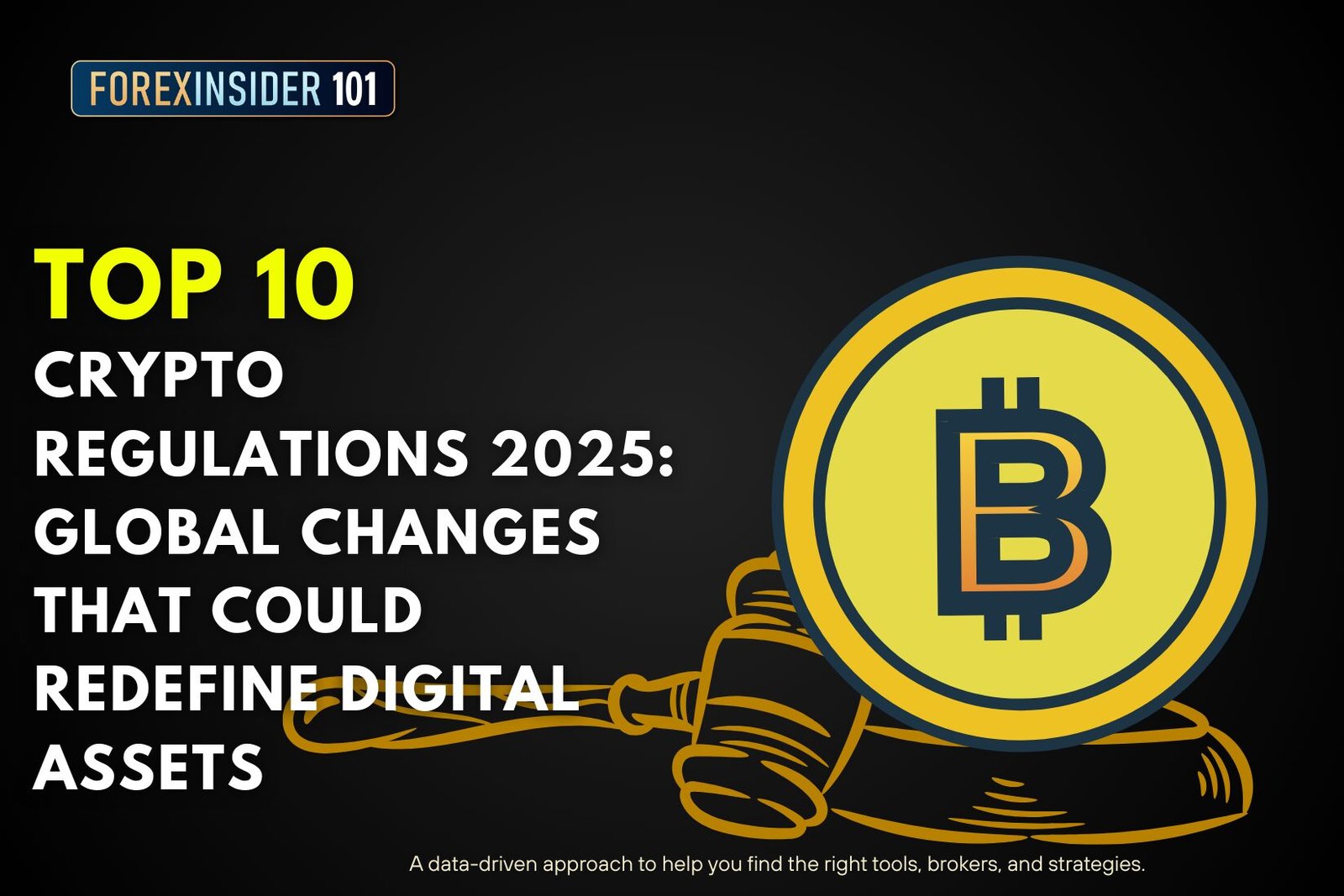The TOP 10 Crypto Regulations 2025 reflect a critical turning point in the cryptocurrency sector. Only a few years ago, most rules were vague, reactive, and inconsistent across borders. Regulators were still debating whether crypto was a passing fad or a permanent feature of global finance. That debate is now over. Digital assets have grown into a multi-trillion-dollar market, prompting governments to design frameworks that integrate crypto into the mainstream economy while mitigating risks such as fraud, market manipulation, and money laundering.
In 2025, the regulatory map is a study in contrasts. Some countries are pushing forward with innovation-friendly rules that encourage growth while protecting consumers. Others have chosen strict controls — or outright bans — to keep crypto activity in check. Stablecoin issuers are being held to near-banking standards, decentralized finance (DeFi) platforms are being pulled into compliance regimes, and tax authorities are extending their reach into peer-to-peer and cross-border transactions. In this environment, understanding the rules isn’t just a legal requirement — it’s a strategic necessity for anyone active in the crypto space.
Before diving into the ten most important trends shaping this year, here’s an overview of how the world’s major jurisdictions currently approach crypto regulation.
Global Regulation Overview 2025
| Region / Country | Legal Status | Main Regulator(s) | Licensing Requirements | Tax Treatment | Notable Restrictions |
|---|---|---|---|---|---|
| United States | Legal, regulated | SEC, CFTC, FinCEN, OFAC, IRS | Federal & state licenses | Property classification | AML/KYC, Travel Rule, SEC oversight |
| European Union | Legal | ESMA & national regulators | MiCA license | Varies | AMLD5/6 compliance, consumer protection |
| China | Banned | N/A | N/A | N/A | Total ban on trading and mining |
| Japan | Legal | FSA, JVCEA | FSA registration | Misc. income | Remittance limits, strict AML |
| Singapore | Legal | MAS | MAS licensing | Varies | Retail marketing restrictions, stablecoin framework |
| South Korea | Legal, regulated | FSC | Licensing under 2023 Act | Tax deferred | Ban on privacy coins |
| UK | Legal | FCA | FCA registration | CGT applies | Ban on retail derivatives |
| Australia | Legal | AUSTRAC | AUSTRAC registration | CGT applies | Privacy coin ban |
| Canada | Legal | FINTRAC, securities regulators | Platform registration | Commodity treatment | Custody & insurance rules |
| India | Legal but restrictive | RBI, Finance Ministry | None | 30% gains tax | High taxation, loss offset ban |
1. Expansion of AML & KYC Frameworks

Source: Linkedin
Anti-Money Laundering (AML) and Know Your Customer (KYC) requirements are tightening across the globe in 2025, with regulators making it clear that anonymity in financial transactions is no longer acceptable at scale. The Financial Action Task Force (FATF) has pushed countries to adopt and enforce the “Travel Rule,” requiring exchanges and wallet providers to collect and share transaction details for both senders and recipients. This means that even peer-to-peer transfers, once thought to be outside the scope of regulation, are now under scrutiny in some regions.
For businesses, these measures demand more advanced compliance systems and identity verification tools, raising operational costs. For users, they signal a shift toward reduced privacy, even in decentralized ecosystems. While proponents argue that these rules are necessary to prevent illicit finance, critics warn they could stifle innovation and push activity to unregulated jurisdictions.
2. Stablecoin Oversight Becomes Banking-Level

Source: Ledger Insights
Stablecoins, once a lightly regulated corner of the crypto market, are now facing some of the strictest oversight in the industry. In 2025, major jurisdictions such as Singapore, Japan, and the EU have introduced rules that require issuers to maintain fully audited reserves, hold capital buffers, and obtain operating licenses similar to financial institutions. This means popular stablecoins will need to prove, often in real time, that they are backed by actual assets in reserve accounts.
The rationale is clear: stablecoins are a critical bridge between the crypto world and traditional finance, and any instability in their value could ripple across both systems. The collapse of undercollateralized projects in recent years has strengthened the case for regulation. While these measures increase transparency and trust, they may also drive smaller or offshore issuers out of major markets, consolidating the stablecoin landscape around a handful of compliant players.
3. DeFi Enters the Regulated Arena

Source: pa
Decentralized Finance (DeFi) platforms were long considered immune to the reach of traditional regulators because they operate without centralized intermediaries. But in 2025, that perception is changing fast. Authorities in the U.S., EU, and parts of Asia are exploring how to regulate front-end interfaces, governance token holders, and even liquidity providers under existing financial laws.
For example, a DeFi lending protocol might be required to register as a financial service provider if its developers or core team maintain significant control over the platform’s operations. DAOs, too, are in the spotlight, with some jurisdictions considering whether they should be treated as corporate entities for tax and liability purposes. While these steps may bring legitimacy to DeFi, they also challenge the ethos of permissionless and borderless finance that has fueled its growth.
4. U.S. Political and Regulatory Shifts

Source: Blockonomi
The United States remains one of the most influential markets for crypto, and in 2025, political leadership is signaling a possible change in tone. The Trump administration has hinted at easing certain restrictions and resolving long-standing conflicts between the SEC and CFTC over jurisdiction. This could result in a more unified regulatory approach, reducing the uncertainty that has plagued U.S.-based crypto businesses.
However, this is not a wholesale retreat from oversight. Enforcement actions against unregistered securities offerings, fraudulent schemes, and non-compliant exchanges remain a priority for agencies like the SEC and FinCEN. The message is clear: there may be room for innovation, but compliance will not be optional.
5. MiCA in Full Effect Across Europe – TOP 10 Crypto Regulations

Source: beincrypto
The EU’s Markets in Crypto-Assets Regulation (MiCA) is now fully operational in 2025, marking one of the most comprehensive attempts to regulate digital assets on a regional scale. By securing a MiCA license, firms gain the ability to operate across all EU member states, eliminating the need for multiple national registrations. In exchange, they must adhere to strict rules on consumer protection, anti-money laundering, and operational transparency.
This unified framework has been welcomed by many in the industry as it provides legal clarity and fosters cross-border growth. However, smaller players may struggle to meet the compliance requirements, potentially leading to a wave of consolidation in the European crypto market.
6. Asia’s Varied Regulatory Strategies – TOP 10 Crypto Regulations

Source: Digwatch
Asia continues to be a region of mixed approaches in 2025. Japan’s Financial Services Agency (FSA) maintains a reputation for rigorous oversight, requiring exchanges to register and comply with some of the strictest AML rules globally. Singapore’s Monetary Authority of Singapore (MAS) is tightening its licensing regime, particularly around retail marketing of crypto products, while also introducing a stablecoin framework. South Korea enforces its 2023 Act on Virtual Asset Users, which includes a ban on privacy coins and new operational requirements for exchanges.
These measures demonstrate that Asian regulators are trying to strike a balance — allowing crypto innovation to flourish, but only within clearly defined safety rails.
7. Complete or Partial Crypto Bans Persist -TOP 10 Crypto Regulations
Not all countries are embracing digital assets. China maintains its blanket ban on crypto trading and mining, forcing activity underground or overseas. India stops short of an outright ban but imposes a 30% tax on crypto gains and prohibits loss offsets, making active trading financially unattractive for many.
Such restrictive environments tend to drive talent, capital, and innovation toward more open markets. Over time, this could deepen the divide between crypto-friendly and crypto-hostile jurisdictions, with corresponding effects on global market liquidity.
8. Growth of Cross-Border Enforcement – TOP 10 Crypto Regulations
In a market as global as crypto, illicit activities rarely stay confined to one jurisdiction. Recognizing this, regulators are ramping up cross-border cooperation. Agencies are sharing intelligence on suspicious transactions, coordinating sanctions enforcement, and collaborating on high-profile fraud cases.
This trend makes it increasingly difficult for bad actors to evade detection by simply moving operations across borders. For legitimate businesses, however, it also means that compliance failures in one country could trigger investigations elsewhere, raising the stakes for global operations.
9. CBDCs Enter the Mainstream

Source: Indodax
Central Bank Digital Currencies (CBDCs) are moving from pilot projects to live deployment in several economies. China’s digital yuan is already in use in select cities, while the European Central Bank is progressing with its digital euro plans. These state-backed digital currencies are designed to coexist with — but in some cases compete against — private cryptocurrencies, especially in retail payments.
In practice, CBDC rollouts often come with tighter restrictions on the use of private digital currencies for payments, as governments aim to channel transactions into state-controlled systems. This dynamic could reshape the payment landscape, particularly in countries where crypto adoption has been high.
10. New Era of Crypto Tax Compliance
Tax authorities worldwide are closing the gaps in crypto reporting. In 2025, new rules in multiple jurisdictions require disclosure of wallet-to-wallet transfers, cross-border transactions, and holdings on decentralized platforms. The U.S. Internal Revenue Service, the Australian Tax Office, and the Canada Revenue Agency are all expanding their definitions of taxable events.
Some countries are even exploring real-time tax reporting systems, where exchanges automatically report transactions to tax authorities. While this increases transparency, it also raises concerns about privacy and administrative burdens for traders.
Conclusion
The TOP 10 Crypto Regulations 2025 show an industry at the crossroads of innovation and oversight. Stablecoin audits, DeFi governance rules, cross-border enforcement, and new tax frameworks are reshaping the way crypto operates globally. For some, these measures will feel like a barrier; for others, they mark the beginning of a more stable and mature market. Either way, regulation is now central to crypto’s future — and staying ahead of the curve will be essential for survival and success.



